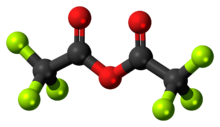Trifluoroacetic anhydride
Topic: Chemistry
 From HandWiki - Reading time: 2 min
From HandWiki - Reading time: 2 min

| |

| |
| Names | |
|---|---|
| Preferred IUPAC name
Trifluoroacetic anhydride | |
Other names
| |
| Identifiers | |
3D model (JSmol)
|
|
| ChemSpider | |
| EC Number |
|
PubChem CID
|
|
| UNII | |
| |
| |
| Properties | |
| C4F6O3 | |
| Molar mass | 210.031 g·mol−1 |
| Appearance | colorless liquid |
| Density | 1.511 g/mL (20°C) |
| Melting point | −65 °C (−85 °F; 208 K) |
| Boiling point | 40 °C (104 °F; 313 K) |
| reacts | |
| Solubility | soluble in benzene, dichloromethane, ether, DMF, THF, acetonitrile |
| Hazards | |
| Safety data sheet | Oxford MSDS |
| GHS pictograms |   [1] [1]
|
| GHS Signal word | Danger |
| H314, H332[1] | |
| P280, P305+351+338, P310 [1] | |
Except where otherwise noted, data are given for materials in their standard state (at 25 °C [77 °F], 100 kPa). | |
| Infobox references | |
Trifluoroacetic anhydride (TFAA) is the acid anhydride of trifluoroacetic acid. It is the perfluorinated derivative of acetic anhydride.
Preparation
Trifluoroacetic anhydride was originally prepared by the dehydration of trifluoroacetic acid with phosphorus pentoxide.[2] The dehydration might also be carried out with excess α-halogenated acid chlorides. For example, with dichloroacetyl chloride:[3]
- 2 CF3COOH + Cl2CHCOCl → (CF3CO)2O + Cl2CHCOOH + HCl
Uses
Trifluoroacetic anhydride has various uses in organic synthesis.
It may be used to introduce the corresponding trifluoroacetyl group, for which it is more convenient than the corresponding acyl chloride, trifluoroacetyl chloride, which is a gas.
It can be used to promote reactions of carboxylic acids, including nucleophilic acyl substitution, Friedel-Crafts acylation, and acylation of other unsaturated compounds. Other electrophilic aromatic substitution reactions can also be promoted with trifluoroacetic anhydride, including nitration, sulfonation and nitrosylation.[2]
Similar to acetic anhydride, trifluoroacetic anhydride can be used as a dehydrating agent and as an activator for the Pummerer rearrangement.[4]
It can be used in place of oxalyl chloride in the Swern oxidation, allowing temperatures up to −30 °C.[5]
With sodium iodide, it reduces sulfoxides to sulfides.[4]
Trifluoroacetic anhydride is the recommended desiccant for trifluoroacetic acid.[6]
References
- ↑ 1.0 1.1 1.2 Sigma-Aldrich Co., Trifluoroacetic Anhydride. Retrieved on 2020-06-08.
- ↑ 2.0 2.1 Tedder, J. M. (1955). "The Use of Trifluoroacetic Anhydride and Related Compounds in Organic Synthesis". Chem. Rev. 55 (5): 787-827. doi:10.1021/cr50005a001.
- ↑ Amiet, Louis & Camille Disdier, "Process for the preparation of trifluoroacetic anhydride", US patent 4595541, published 1986-06-17, assigned to Rhone Poulenc Specialites Chimiques
- ↑ 4.0 4.1 Sweeney, Joseph; Perkins, Gemma; DiMauro, Erin F.; Hodous, Brian L. (2005). "Trifluoroacetic Anhydride". Encyclopedia of Reagents for Organic Synthesis. John Wiley & Sons. doi:10.1002/047084289X.rt237.pub2. ISBN 9780470842898.
- ↑ Omura, Kanji; Sharma, Ashok K.; Swern, Daniel. "Dimethyl Sulfoxide-Trifluoroacetic Anhydride. New Reagent for Oxidation of Alcohols to Carbonyls". J. Org. Chem. 41 (6): 957-962. doi:10.1021/jo00868a012.
- ↑ Chai, Christina Li Lin; Armarego, W. L. F. (2003) (Google Books excerpt). Purification of laboratory chemicals. Oxford: Butterworth-Heinemann. pp. 376. ISBN 0-7506-7571-3. https://books.google.com/books?id=SYzm1tx2z3QC&pg=PA376.
 |
 KSF
KSF